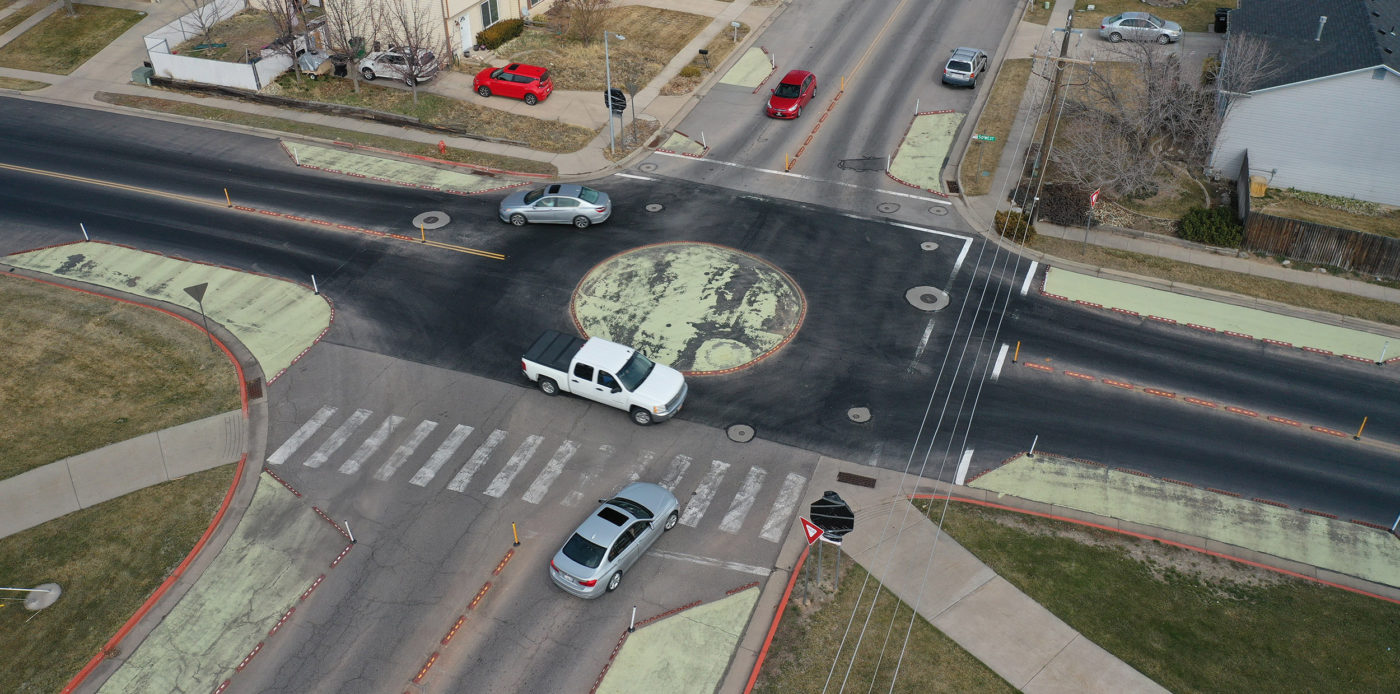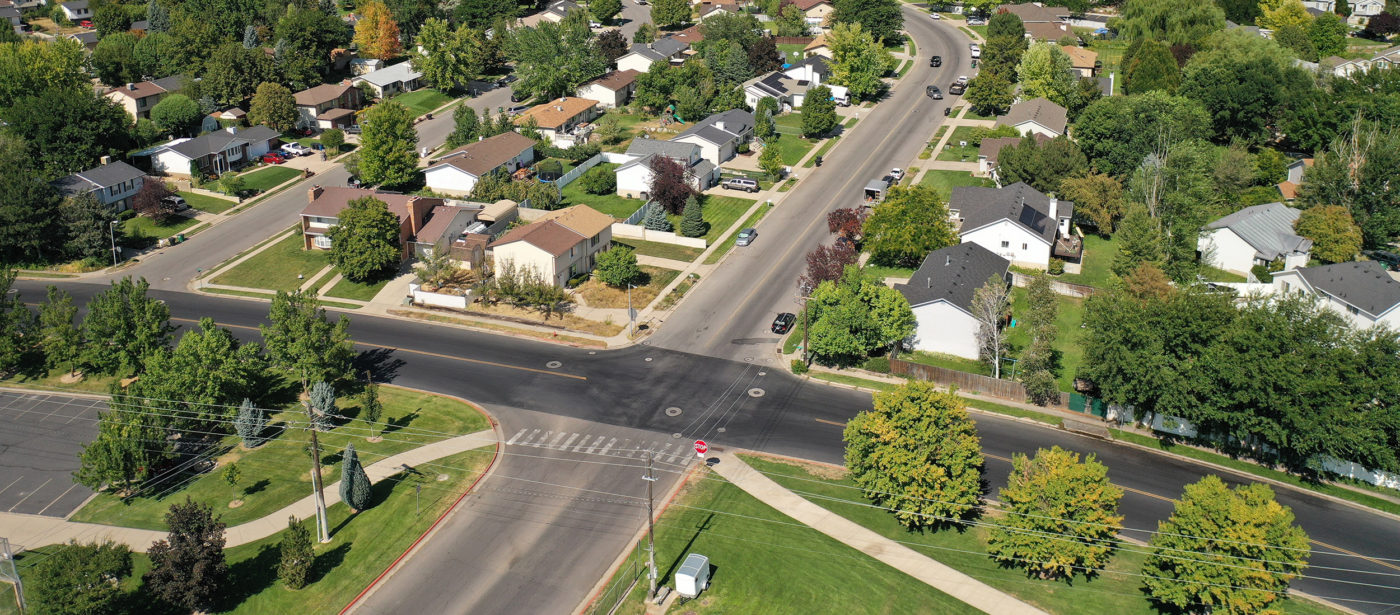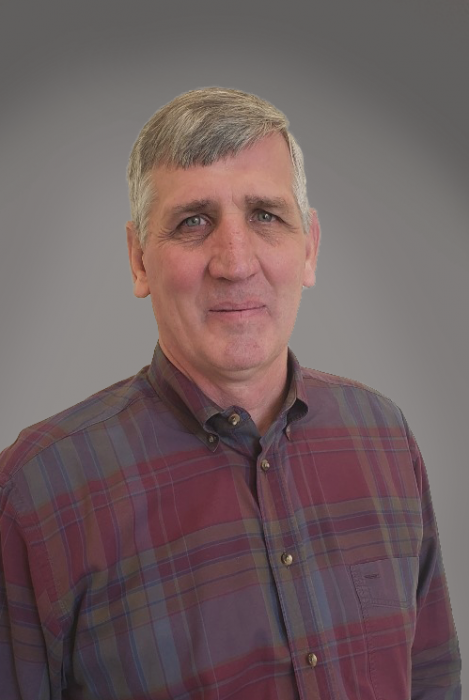Install a Temporary Roundabout to Evaluate a Permanent Solution

Public opinion on roundabouts varies – some people think they are a better alternative than a stoplight, while others believe them a safety risk. A community considering a roundabout might first want to install a temporary prototype of it to see how the drivers and pedestrians react to this change.
Kaysville, UT, took that step by approving the installation of a temporary roundabout to see if it met their needs for improved traffic flow and safety where Burton Lane and 50 West come together. With rubber bumpers and plastic delineators, the temporary structure allowed engineers to test their technical solution without a significant financial investment while also gauging their citizens.
As part of the research, CRS wanted feedback on how it was working. The temporary roundabout was in place for over a year. During that time, CRS interacted with residents on a dedicated Facebook page and checked in with City officials who frequently heard from the community.
Why a Roundabout?
The roundabout was suggested for the Burton Lane location to help disperse the traffic more evenly from the entering roads as traffic peaks during local park venue sporting events and is quiet at other times. Safety was another consideration. Pedestrians crossing the streets are at risk from people using Burton Lane for overflow parking during events.
But modern roundabouts, like the one being trialed in Kaysville, are not as big as a multilane roundabout or as tight as a traffic circle. These roundabouts are an excellent alternative to a traffic signal and usually have just one lane with vehicles traveling 15-25 mph. It requires drivers who want to enter the circular intersection to yield to the vehicles already circling the roundabout.
Kaysville has another roundabout near Snow Horse Elementary School that has created a safer entrance to the school for pedestrians while allowing traffic to flow more consistently. Because of this successful solution, City officials also considered a roundabout at the Burton Lane site.

The Burton Lane and 50 West intersection before the installation of the temporary roundabout used to evaluate the traffic flow
Research
Before installing the roundabout, CRS used a special camera to monitor the traffic on the two roads, assessing approach speeds and counting the number and direction of cars that went through. Once the temporary structure was installed, the camera continued to monitor traffic, comparing the initial data to determine safety and flow.
See the full range of CRS traffic engineering projects and expertise.
Installing the temporary roundabout before the permanent one allowed CRS and the City to:
- Collect traffic information without a large capital cost in infrastructure
- Test the proposed solution, even making slight changes to geometry, if needed
- Learn how to best overcome some of the resident concerns prior to implementing the final configuration
- Avoid planning and construction delays since we could gather information on how our proposed configuration would function
Results
Many concerns and responses came out of the public contact regarding the temporary roundabout and the project in general. CRS addressed many of the concerns with the permanent design.
| Concern Identified | Response |
|---|---|
| The roundabout creates too tight a turn. | The permanent one will be larger. |
| Pedestrian access is limited as the structure is too close to the crosswalk. | A permanent roundabout application would pull back the crosswalks away from the intersection. |
| It’s too small; you will need to take out nearby houses. | Right-of-way property will be obtained from the park, leaving homeowners’ property intact. |
| It needs to have a greater diameter to accommodate larger trailers. | Roundabouts are built with a mountable center circle for large vehicles such as trucks to be able to make the turn. |
| Cars pull out in front of pedestrians; it’s hard to navigate the circle while noticing pedestrians in the crosswalk. | The final roundabout will be larger and allow more time for drivers to notice pedestrians |
| There’s not enough traffic to warrant a roundabout or a traffic signal. | Roundabouts provide traffic control during peak times but allow for the free flow of traffic at off-peak times. |
| What improved safety measures does this add, besides decelerating traffic? | The roundabout will add better pedestrian crossings and visibility. |
| There’s a bottleneck into the roundabout. | The vehicle flow will improve with the larger, permanent roundabout. |
| We’re concerned for the safety of children while crossing 50 West and Burton Lane. | Roundabouts have been proven to be safer for pedestrians to navigate at an intersection. |
| School buses have a hard time navigating it. | The roundabout has rubber bumpers that are designed to be driven over. |
| Please consider a push-button light up sign for pedestrian crossing instead of the roundabout. | A roundabout is more cost-effective than a traffic light and provides an overall improvement in flow and safety at the intersection. |
After the research was completed, officials determined that the roundabout was the best solution at this location and secured the funding to implement a full-scale version with support from the residents.
For more information on the Kaysville Roundabout and how a roundabout may solve traffic issues at an intersection in your community, contact Andy Thompson at andy.tompson@crsengineers.com.

